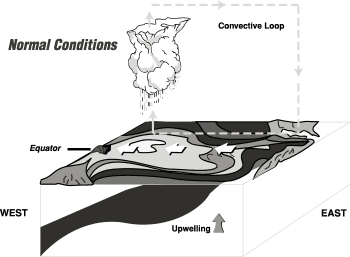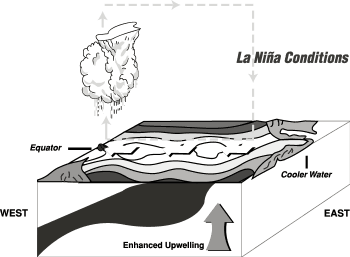 The coupled atmosphere-ocean phenomenon known as El Niño is frequently followed
by a period of normal conditions in the equatorial Pacific Ocean. Sometimes, but
not always, El Niño conditions give way to the other extreme of the El
Niño-Southern Oscillation (ENSO) cycle. This cold counterpart to El Niño is
known as La Niña, Spanish for "the girl child." The coupled atmosphere-ocean phenomenon known as El Niño is frequently followed
by a period of normal conditions in the equatorial Pacific Ocean. Sometimes, but
not always, El Niño conditions give way to the other extreme of the El
Niño-Southern Oscillation (ENSO) cycle. This cold counterpart to El Niño is
known as La Niña, Spanish for "the girl child."
The Southern Oscillation
While researching the collapse of the rainy phase of the monsoon system and
resulting drought that occurred in India during the early years of the 20th
century, Sir Gilbert Walker discovered a seesaw variation in pressure between
the eastern and western Pacific Ocean. Walker found that when air pressure was
high at Darwin, Australia (western Pacific) it was low at Tahiti (eastern
Pacific), and when air pressure was low at Darwin, it was high at Tahiti.
Walker, however, failed to make the connection between this oscillating pressure
pattern and El Niño. This link was made convincingly in the 1960s by the
Norwegian meteorologist Jacob Bjerknes, who was also researching the anomalous
drought in India.
How La Niña Forms
Researchers discovered that during non-El Niño years, surface pressures tend to
be low over the warm waters of the equatorial western Pacific as overlying warm
moist air rises and then diverges aloft. Over the colder waters of the eastern
equatorial Pacific, surface pressures tend to be higher as converging winds
aloft contribute to the sinking of cool air. In much the same way as a ball
rolls down a hill, air flows from high pressure in the east to low pressure in
the west along this equatorial pressure gradient. This contrast in pressure is
what drives the trade winds, the prevailing large-scale surface winds that blow
from east to west. As these winds blow along the surface of the equatorial
waters, there is a net transport of ocean water in a westward direction. As
this occurs, cold, nutrient-rich water rises up (or upwells) along the coast of
South America to replace the westward-moving surface water. This upwelling
brings nutrients to the surface waters off the coast allowing the fish
population living in these upper waters to thrive.
During La Niña years, the trade winds are unusually strong due to an enhanced
pressure gradient between the eastern and western Pacific. As a result,
upwelling is enhanced along the coast of South America, contributing to colder
than normal surface waters over the eastern tropical Pacific and warmer than
normal surface waters in the western tropical Pacific.


next: The Effects of La Niña |
|
by Steve Graham
April 27, 1999

La Niña
The Southern Oscillation
The Effects of La Niña
NASA and NOAA Missions to Study La Niña
|


 The coupled atmosphere-ocean phenomenon known as El Niño is frequently followed
by a period of normal conditions in the equatorial Pacific Ocean. Sometimes, but
not always, El Niño conditions give way to the other extreme of the El
Niño-Southern Oscillation (ENSO) cycle. This cold counterpart to El Niño is
known as La Niña, Spanish for "the girl child."
The coupled atmosphere-ocean phenomenon known as El Niño is frequently followed
by a period of normal conditions in the equatorial Pacific Ocean. Sometimes, but
not always, El Niño conditions give way to the other extreme of the El
Niño-Southern Oscillation (ENSO) cycle. This cold counterpart to El Niño is
known as La Niña, Spanish for "the girl child."
